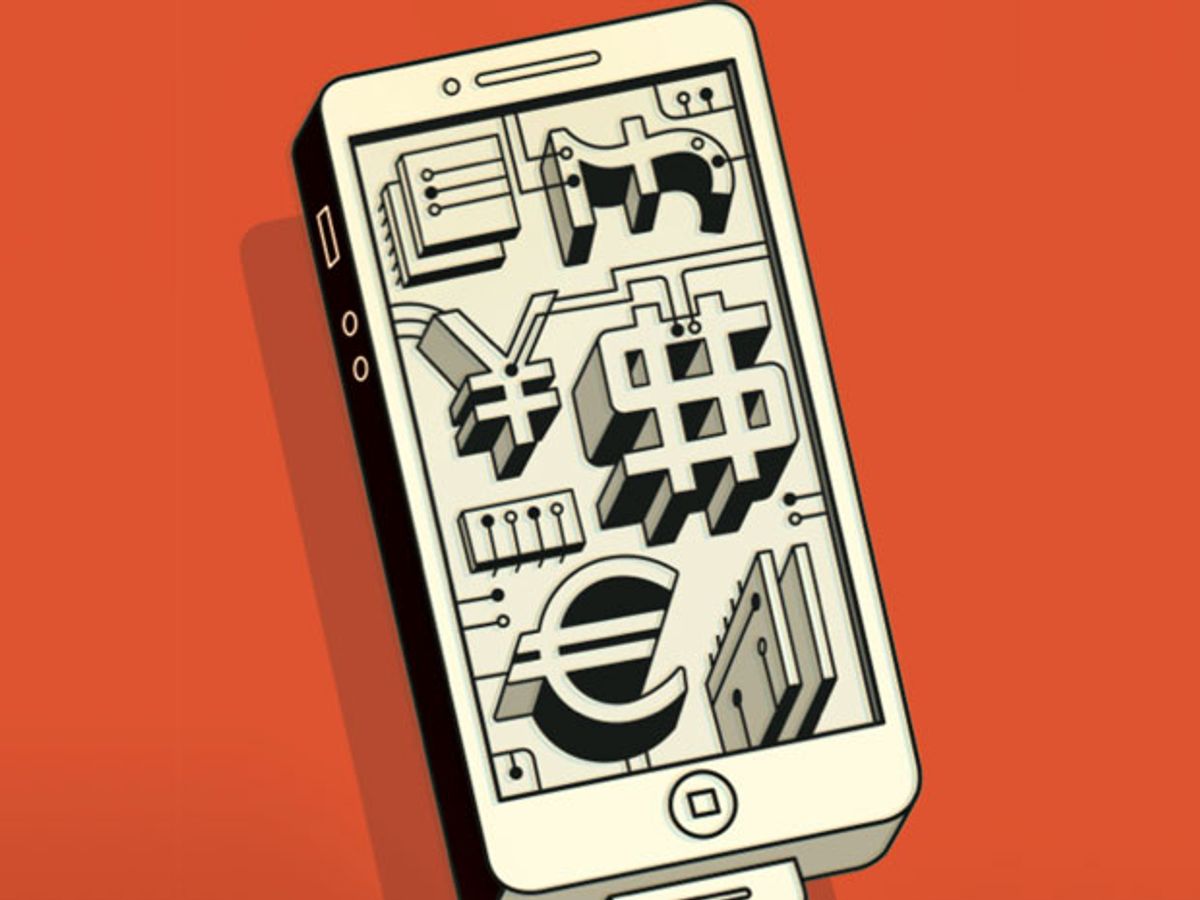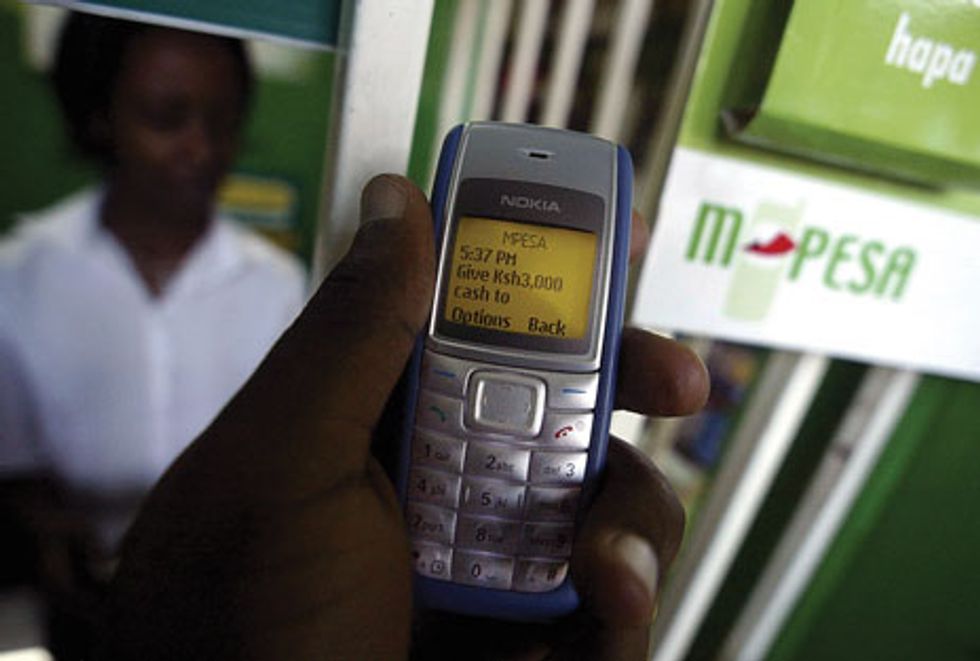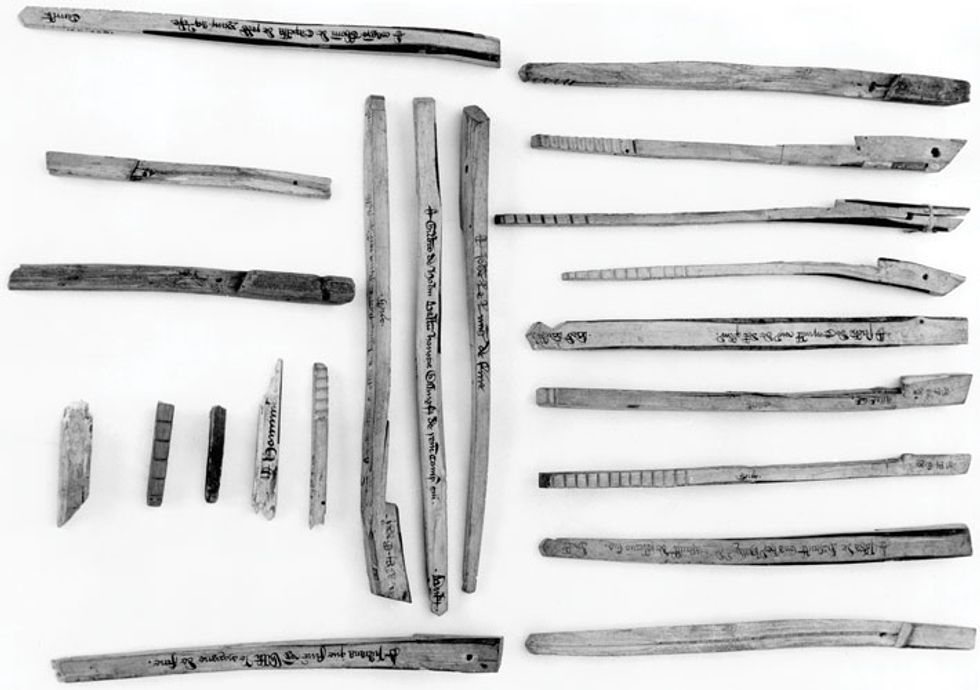There’s No Stopping the Rise of E-Money
The economic and psychological underpinnings of hard money are weakening while the flexibility of e-money increases

Science-fiction writers once imagined a galactic currency that would grease the wheels of commerce from here to Alpha Centauri. In fact, however, we are tending in precisely the other direction, toward a burgeoning number of ever more specialized currencies. These will circulate electronically, by means of the mobile phones that are increasingly part of the dress of every person on the planet.
Seemingly everywhere you look, you can see the emergence of this pattern in what futurologists call the weak signals [PDF] of change. These are the changes that will be seen, a generation from now, to have foreshadowed a technological revolution.
That money is a technology is obvious, once you look at it. It is not a feature of the natural world but rather a constructed tool, one that defines a way of doing things. It is a clearly specified standard, like the Internet Protocol, the gauges used in rail transport, or the octane specifications of gasoline. And it can change.
What’s more, like all technologies, money exhibits the law of unintended consequences. The historian David Edgerton wrote in The Shock of the Old: Technology and Global History Since 1900 (Profile Books, 2006) that as a technology moves through a culture, its downstream uses are often very different from what its inventors had imagined. This fact stands squarely in the way of anyone who would claim to see just where a new technology will take us.
Today, the technology of money is racing to catch up to social changes that have radically altered how people interact and therefore how, why, and when they use money. It’s impossible to say what the unintended consequences of these innovations in financial technology will be; we can only note that they will come, and make some intelligent guesses. I believe, though, that in the end, money as we know it will be turned on its head, and this revolution will be at least as profound as the introduction of paper money a millennium ago.
Of course, society has been through times of innovation in monetary technology before. Consider the “split tally,” a wooden stick used to record royal taxes in England. Tallies came into use shortly after the Norman invasion of 1066 and were not withdrawn until 1826 (we Brits are a conservative bunch). The sheriff would collect the taxes based on tax assessments and then remit the collected cash to the king. To ensure that both the sheriff and the king knew where they stood, the tax assessment was recorded by cutting notches in a wooden twig. The twig was then split, so that the king and the sheriff each had a durable record of the assessment. When it was time to “tally up,” the sheriff would show up with the cash and his half of the tally to be reckoned against the king’s half.
The technology worked well. The sticks were small and long-lasting (very long—some of them still exist), they were easy to store and transport, and they were easily understood by those who couldn’t read (which was almost everyone, in the early days). They were also secure: Neither the sheriff nor even the king could forge one half of the stick without having the other half.
The tally was soon finding unforeseen uses. The king often couldn’t wait until taxes fell due; he wanted his cash as soon as possible (generally for wars with the French or the Scots). So he would sell his half of the stick at a discount. The buyer could then get the cash when the taxes fell due. This made that half of the tally stick, in effect, a fixed-term government bond. The market for tallies evolved quickly. Say someone in Bristol held a tally for taxes due in York; to collect the payment, he’d either have to travel to York or find someone else who would do the job for him, for an appropriate discount. Thus a money technology intended only for record keeping evolved into a thriving market.
The mobile phone is the new tally stick. It will evolve in unforeseen ways, and both the push exerted by the new technology and the pull exerted by society’s changing needs will shape the outcome. And the result, I believe, will be revolutionary change.
In Japan and Korea [PDF], mobile phones have been used for payments for a decade, and the technology is now a standard feature there in handsets. In March, one out of six Japanese users bought something in a shop using a mobile. People also use the system to pay bills and transit fares; businesses use it to funnel loyalty rewards to customers. At first, the number of retailers accepting the new technology remained flat; once about a third of consumers were using it, though, things started to take off, producing the “hockey stick” adoption curve that we technologists love.
What’s happening in Africa is even more astonishing. Kenya is now home to the world’s most expansive mobile payments scheme, M-Pesa [PDF]. (I should disclose that my employer, Consult Hyperion, provided paid professional services for the M-Pesa project.) It was launched in 2007—not by a bank but by the country’s biggest mobile operator, Safaricom, with support from the United Kingdom’s Department for International Development. The system’s nearly 15 million users can use their mobile phones to deposit cash into their accounts, using as a point of deposit any of the 28 000 shops around the country that participate. Users can then move their deposited money about with an application built on top of the text-messaging function of their phones. When they want to buy something, they just text the money to another person, shop, or bank that is also in the system; money is then debited from the payer’s account and credited to that entity’s account.
A third of Kenya’s gross domestic product now flows through M-Pesa, and an amazing range of new businesses have sprung up to use it, none of which were envisaged by its founders. Farmers buying insurance to take animals to market, bars that operate cash free (and therefore robbery free), shops that use it as a kind of “night safe,” savings accounts that can be accessed only from online—all these have been made possible by the new tally stick.
One reason it has taken off so splendidly is that so many people in Kenya lack credit cards and bank accounts. To send cash to a relative in a far-off village, you might have to pay a courier to take it there—for a tremendously high transaction cost. The proof was in the service’s growth: Within a year of its launch in 2007 it had 5 million subscribers, more than all 43 of Kenya’s commercial banks put together. The M-Pesa network is now being replicated in Tanzania, Uganda, and other countries.
The rest of the world is starting to move. In the U.K., the Payments Council—a coordinating body for the financial industry, set up in 2007 by government order—has begun working on a national mobile payment infrastructure. In France, mobile phone operators and banks have gotten together to launch a system for mobile proximity payments, which lets a chip-bearing platform transfer money when held close to the reader. In Germany, meanwhile, the mobile phone operators have decided to ignore the banks and go it alone. In the United States, Google is working with Sprint and MasterCard to launch Google Wallet, while AT&T, Verizon, and their partners are planning a rival called Isis Mobile Wallet (although the U.S. market is a tough one—see “Phone-y Money,” in this issue). Other mobile money schemes are hatching in Mexico, Russia, Vietnam, and elsewhere.
All this activity has people once again talking about a cashless society. Because let’s face it: Cash is expensive. In the United States, for instance, studies indicate that maintaining a cash system—including printing new bills, recycling old ones, moving them about in armored trucks, using them to replenish automatic cash machines—costs the country about 1 percent of GDP. Those studies also show that the marginal cost of a cash transaction is around double that of a debit-card transaction.
Cash’s indirect costs are huge, too. In a 2011 study [PDF], Edgar L. Feige of the University of Wisconsin, in Madison, and Richard Cebula of Jacksonville University, in Florida, found that in the United States 18 to 19 percent of total reportable income is hidden from federal tax men, a shortfall of about US $500 billion. The Justice Department estimated in 2008 that secret offshore bank accounts were responsible for about one-fifth of the tax gap, suggesting that the remaining 80 percent is attributable to unreported cash.
The need to get beyond cash has been recognized in a number of countries. In the Netherlands, there are commercial streets that are cash free, and many supermarkets have cash-only lanes that are open for just part of the day. In Sweden the government and labor unions have come together to start reducing the amount of cash in circulation. The labor unions want to remove cash from shops and banks because it is their members who get beaten and shot in robberies; the government wants to reduce the burden of police work.

Thus the allure of the mobile phone as an alternative to cash. The enabling technology has finally arrived, and it’s taking root because the business drivers (that is, the high cost of cash) and the social drivers (cash’s disproportionate cost to the poor) were already there. And just as the plastic card and the Web made it easy for us to pay merchants, the mobile phone will soon make it easy for us to pay each other.
So let's assume that the mobile phone will take over and that in a few years’ time, you’ll be able to pay Walmart or your window cleaner or your niece with your mobile phone. In this world, switching among dollars and euros and frequent-flier miles and Facebook Credits and Google Bucks and any other form of money will be just a matter of choosing from a menu on the phone. The cost of introducing new currencies will collapse—anyone will be able to do it. The future of money, in other words, won’t be that single galactic currency of science fiction. (We already know that, because we can’t even make a single currency work between Germany and Greece, let alone Ganymede and Gamma Centauri.) Instead, we can look forward not merely to hundreds but thousands or even millions of currencies. And though regulators may oppose the trend, they can’t hold it back.
That must sound as crazy to you as the idea of paper money once did to your ancestors, but it really isn’t. Trying to imagine a wallet with a hundred currencies in it and a Coke machine with a hundred slots for them is, of course, nuts. But based on the available currencies in your mobile “wallet” and prevailing market conditions, your phone and the Coke machine will be able to negotiate an exchange rate in a fraction of a second.
Likewise, I don’t want to carry around a hundred different retailer credit and loyalty cards, but my phone can hold a zillion. So when I go to Starbucks, my phone will select my Starbucks app, load up my Starbucks account, and generally not bother me about the details. When I walk next door into Target, my phone will select my Target app, fire up my Target card, and get down to business.
Who will want to issue these new currencies? Corporations, for starters. When Edward de Bono wrote The IBM Dollar: A Proposal for the Wider Use of “Target” Currencies back in 1994, he looked forward to a time when “the successors to Bill Gates will have put the successors to Alan Greenspan out of business,” arguing that it would be more efficient for companies to issue money than equity. Even if all I’ve got is Microsoft Moola, and you want to get paid in Samsung Shekels, who cares? Our phones can sort it out for us.
Other obvious money-issuing entities will be communities that constitute a natural domain for a kind of money—communities defined by region, political jurisdiction, or participation in some activity. In South London we already have the Brixton Pound, a merchant-managed e-currency that’s exchangeable for regular pounds. Proponents say it fosters local business; detractors say it puts up an informal barrier to trade. In either case, it demonstrates a degree of local control over money.
The effects on the total supply of money are hard to determine. However, I see no reason why this system would require a central authority to settle up accounts at the end of the day. I would imagine that there will instead be lots of different exchanges settling among different types of currencies.
Such local currencies will follow the decadelong minting of virtual money in various online games, Facebook Credits, and a host of promotions—including some that will no doubt soon become transferable in a way that today’s frequent-flier miles are not. These will merge and surge, forming a panoply of private currencies that will give users more ways to pay for things and thus make trade more efficient. Some currencies will excel for transactional purposes, others for economic stability, and perhaps some will just be fun. But in the long term, we will be better off.
The mobile phone will change money forever. It will start by providing a convenient means of exchange, but in so doing it will trigger a new monetary order. That’s not a bad thing. It’s progress.
This article originally appeared in print as “Let a Thousand Currencies Bloom.”
About the Author
David G.W. Birch is a director of Consult Hyperion, which specializes in secure electronic transactions. For 15 years he has organized the annual Digital Money Forum, in London, which explores the history and future of transactions. He first realized how little the public understood about money when a British journalist told him she’d always thought the pound was backed by a pile of gold in a basement. “I had to laugh,” he says.

